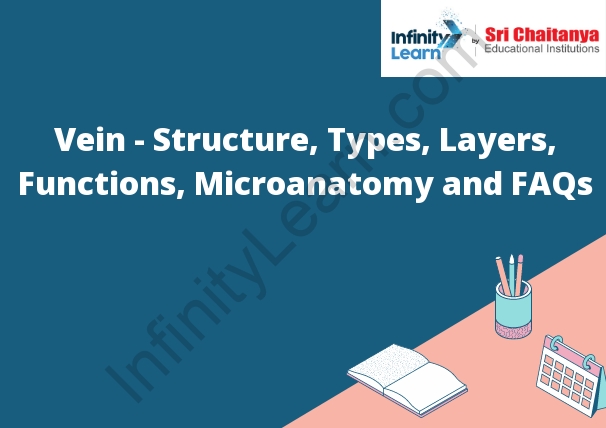Table of Contents
Vein Blood Vessel
A vein is a blood vessel that carries blood from other parts of the body back to the heart. Veins are typically thinner and softer than arteries.
There are three types of veins: superficial veins, deep veins, and pulmonary veins.
- Superficial veins are located near the surface of the skin.
- Deep veins are located deep in the body.
- Pulmonary veins are located in the lungs.

Structure of Veins
Veins are vessels that carry blood from different parts of the body back to the heart. They have thinner walls than arteries and are less muscular. The veins that drain the arms and legs are called superficial veins. These veins are close to the surface of the skin. The veins that carry blood from the internal organs are called deep veins.
Pulmonary and Systemic Veins
- The pulmonary veins are a set of veins that carry deoxygenated blood from the lungs to the left atrium of the heart. The left atrium pumps the blood into the left ventricle, which then pumps it out to the body.
- The systemic veins are a set of veins that carry oxygenated blood from the body to the right atrium of the heart. The right atrium pumps the blood into the right ventricle, which then pumps it out to the lungs.
Deep Veins and Superficial Veins
The deep veins are veins that are located deep within the body, while the superficial veins are veins that are located close to the surface of the skin. The deep veins carry deoxygenated blood from the body’s tissues back to the heart, while the superficial veins carry oxygenated blood from the heart to the body’s tissues. The deep veins are located in the arms, legs, and torso, while the superficial veins are located in the arms and legs.
Layers of Blood Vessels
There are three layers of blood vessels: the tunica intima, the tunica media, and the tunica externa.
- The tunica intima is the inner layer of the blood vessel. It is made up of a layer of epithelial cells and a layer of smooth muscle cells. The epithelial cells line the inside of the blood vessel and the smooth muscle cells control the diameter of the blood vessel.
- The tunica media is the middle layer of the blood vessel. It is made up of a layer of smooth muscle cells and a layer of connective tissue. The smooth muscle cells control the diameter of the blood vessel and the connective tissue provides support for the blood vessel.
- The tunica externa is the outer layer of the blood vessel. It is made up of a layer of connective tissue and a layer of epithelial cells. The connective tissue provides support for the blood vessel and the epithelial cells line the outside of the blood vessel.
Layers of Arteries and Veins
- The arteries and veins are two types of blood vessels. The arteries carry blood away from the heart, and the veins carry blood back to the heart.
- The arteries are made up of three layers: the tunica intima, the tunica media, and the tunica adventitia. The tunica intima is the innermost layer, and it is made up of a layer of cells called the endothelium. The tunica media is the middle layer, and it is made up of muscle cells and elastic tissue. The tunica adventitia is the outer layer, and it is made up of connective tissue.
- The veins are also made up of three layers: the tunica intima, the tunica media, and the tunica adventitia. The tunica intima is the innermost layer, and it is made up of a layer of cells called the endothelium. The tunica media is the middle layer, and it is made up of muscle cells and elastic tissue. The tunica adventitia is the outer layer, and it is made up of connective tissue.
Functions of Veins and Arteries
- The veins and arteries are two types of blood vessels.
- The veins are responsible for returning blood to the heart, while the arteries are responsible for carrying blood away from the heart.
- The veins are thin-walled and have valves that prevent blood from flowing backwards.
- The arteries are thick-walled and have no valves.
Microanatomy
The primary structure of a neuron is its cell body, or soma. The soma contains the neuron’s nucleus, which controls the neuron’s activities. The dendrites branch out from the soma and receive information from other neurons. The axon is a long, thin projection that carries information away from the soma to other neurons.
Conditions that affect the Venous System?
Conditions that affect the venous system include: varicose veins, deep vein thrombosis, and phlebitis.
Tips for Healthy Veins
There are many things you can do to keep your veins healthy and functioning properly.
- Maintain a healthy weight.
- Exercise regularly.
- Avoid sitting or standing for long periods of time.
- Limit your intake of caffeine and alcohol.
- wear compression stockings.
- Quit smoking.
- Elevate your legs when resting.
- See your doctor if you experience any symptoms of vein disease.








